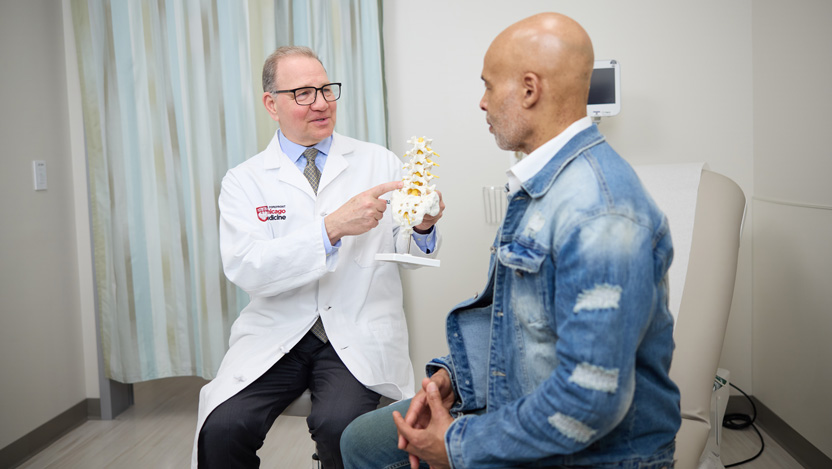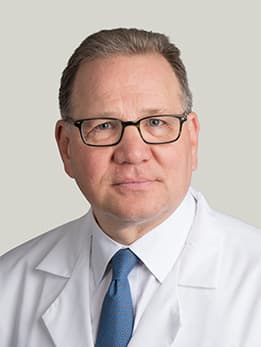Spine Pain: Diagnosis, Treatment & Surgery

Spine Pain Diagnosis
Our experts use a combination of techniques to accurately diagnose back problems:
Medical history
We will start by asking you questions about your symptoms, such as the location, duration and nature of the pain and any activities or movements that aggravate or alleviate it. We may also inquire about any previous injuries or medical conditions related to your back.
Physical examination
We will also conduct a physical examination to assess your back's range of motion, strength, reflexes and sensation.
Imaging tests
Depending on your medical history and physical examination, your spine care team may order imaging tests to get a more detailed view of the spine. Common imaging tests for diagnosing back problems include X-rays, bone density tests, electromyography (EMG), myelogram, magnetic resonance imaging (MRI), computed tomography (CT) scans or bone scans. These tests can help identify fractures, herniated discs, spinal stenosis or other abnormalities.
Schedule a Spine Appointment Online
Comprehensive Spine Pain Treatments
Our goal is always your goal: to reduce or eliminate pain, shorten recovery time and help you return to your daily activities. We believe in a patient-centered process of informed and shared decision-making. Our team of specialists will complete a thorough evaluation to help you determine the right treatment course.
We are committed to listening to and guiding patients through the treatment decision with respect and compassion. We empower our patients to be active participants in their health care and work with us to decide the best option for their condition, symptoms, lifestyle and recovery goals. We walk patients through each step of their healthcare journey – from pain management and rehabilitation at home to outpatient care or surgery.
Your physician may recommend nonsurgical spine treatment – such as physical therapy and anti-inflammatory medication – or surgical treatment. Your treatment plan may include one or more of the following procedures:
Nonsurgical Spine Care
- Comprehensive physical therapy (PT): Daily exercises at home and with a physical therapist to strengthen back muscles, increase flexibility and relieve chronic back pain
- Pain medication management: Oral painkillers or anti-inflammatory medication
- Steroid injection therapy: A lumbar epidural steroid injection (ESI) to relieve pain from a herniated disk and spinal stenosis
- Joint injections: Medication administered directly to the joints to target pain and inflammation
- Nerve blocks: An injection of nerve-numbing medication
Types of Spine Surgery We Perform
Robotic surgery with computer-assisted navigation: Using special software and imaging, surgeons can create a detailed 3D model of the patient's spine and perform surgery with enhanced precision and safety.
- Cervical disk replacement: A surgical procedure known as cervical arthroplasty is used to replace a damaged or diseased cervical disk with an artificial one.
- Microdiscectomy or laminectomy: A minimally invasive surgical procedure to alleviate pain and symptoms caused by a herniated disk or spinal stenosis. Our surgeon uses special tubes and a microscope to examine the disk and nerves. This allows our surgeon to make a smaller cut.
- Traditional spine surgery: Open spine surgery is used for some complex spinal conditions that may not be suitable for minimally invasive techniques.
- Spinal fusion: A procedure to join two or more vertebrae, it creates a solid bone structure to eliminate motion in that area. This can alleviate pain and prevent further movement or shifting of the spine.
- Vertebroplasty: A minimally invasive procedure used to stabilize vertebral fractures caused by osteoporosis, spinal tumors or trauma.
Expert Spine Surgery Options
Our surgical options range from minimally invasive spine surgery to traditional open surgery. Your care team will help you choose the treatment most likely to reduce your pain and maximize mobility.
In the case of back surgery, the goal is to relieve pressure on the nerves of your spine by removing part of a bone or disk or fusing them. Following are some of the most common reasons for spine surgery:
- A disk is bulging or pushing outward, pressing on nearby nerves.
- A disk can become worn out and thin, causing the bone above and below to rub together.
- Bone spurs can form, putting pressure on the nerves.
- A fusion procedure to stabilize the bones of the spine.
Whenever possible, our team uses minimally invasive spine surgery, making smaller incisions that reduce disruption to the surrounding tissue and shorten recovery times. When traditional back surgery is necessary, our world-class surgeons rely on the latest technology to help minimize patients' pain.






